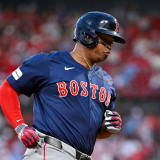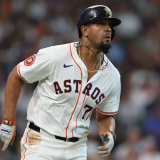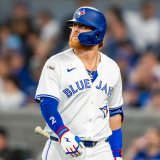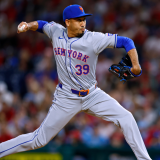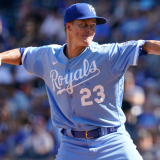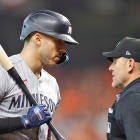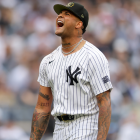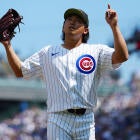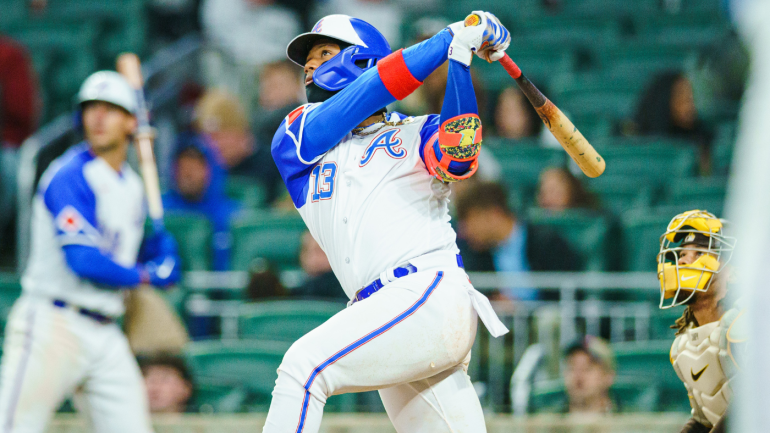
We are now beyond the halfway point of the 2023 MLB season and the All-Star Game at Seattle's T-Mobile Park is next week. Before you know it, we'll be at the trade deadline, then we'll dive right into the postseason races in August and September. The baseball season seems to move a little faster with each passing year, doesn't it?
Our bi-weekly series breaking down various trends across the league continues Wednesday with a look at how two of the best players in the game are getting better, and one surprise contender's clutch bullpen. Two weeks ago we examined three first basemen heading in different directions.
Another way Acuña has improved
By any measure, Braves wunderkind Ronald Acuña Jr. has been one of the very best players in baseball this season. He has put up unreal numbers in the first inning (in all innings, really) and he recently became the first player in history with 20 homers and 35 steals prior to the All-Star break. Acuña took an incredible .335/.413/.599 slash line into Tuesday night's game.
A little more than halfway through the season Acuña is on pace to (or already has) set new career bests in basically every important offensive statistic. Among them: strikeout rate. Acuña owns a stellar 12.5% strikeout rate this season. The league average is 22.7% and Acuña is on par with noted contact hitters like Steven Kwan (12.3%) and Alex Verdugo (13.4%). Acuña had a 23.6% strikeout rate last year, and 25.3% from 2018-22.
Acuña's strikeout rate improvement is the largest in baseball this year. Here are the largest year-to-year strikeout rate improvements among the 292 players with at least 300 plate appearances in both 2022 and 2023:
| 2022 K% | 2023 K% | Change | |
|---|---|---|---|
1. Ronald Acuña Jr., Braves | 23.6% | 12.5% | -11.1% |
2. Luis García, Nationals | 22.3% | 11.8% | -10.5% |
22.6% | 14.0% | -8.6% | |
4. Jorge Soler, Marlins | 29.4% | 22.7% | -6.7% |
5. J.D. Davis, Giants | 33.4% | 27.3% | -6.1% |
Acuña's chase rate (23.5%) is right in line with his career average (22.5%), and so is in his in-zone swing rate (67.6% in 2023 vs. 67.8% career). He's just making more contact when he does swing (82.1% in 2023 vs. 75.7% career), and he's also swinging more often early in the count. Acuña has gone to a two-strike count in 46% of his plate appearances this year. That number was 56% in 2022. See fewer two-strike counts and you're going to strike out less. Pretty obvious correlation there.
Although Acuña is the headliner, the Braves as a team are striking out much less this season. Their 24.6% strikeout rate was third highest in baseball last year. This year the Braves are striking out in only 21.2% of their plate appearances, the seventh-lowest rate in the game. Ozzie Albies, Orlando Arcia, Michael Harris II, Marcell Ozuna, and Austin Riley have all cut their strikeout rates significantly, albeit it not as significantly as Acuña.
"We're not chasing as much," Braves manager Brian Snitker told The Athletic recently. "You're talking about a bunch of young guys that aren't where they're going yet. I think more at-bats and experience, you're going to see continued improvement in all of them, probably. Pretty talented guys. The more you do it, the better you get at it, and they're doing it a lot more now."
The Braves went 21-4 in June, outscored their opponents 175-104 in those 25 games, and hit .307/.372/.572 as a team. They became the first team to hit .300 in a calendar month since the Astros hit .323 in July 2017, a year they had an unfair advantage. Before those Astros in July 2017, the Rangers (.320) and Tigers (.310) in September 2011 were the last teams to hit .300 in a calendar month. Atlanta is in juggernaut mode right now and Acuña's suddenly high contact bat is leading the way.
Mookie the infielder
I'm convinced there is nothing Mookie Betts can't do on a baseball field. He can play any kind of offensive game (power, speed, contact, etc.) and he's a tremendous defender anywhere you put him. The Dodgers have certainly tested that theory this season. They've had to play Mookie at shortstop out of necessity, and the result has been plays like this:
Betts was drafted as a shortstop, though he only played 14 games there in the low minors before moving to second base and then the outfield, partly because the Red Sox had Dustin Pedroia and Xander Bogaerts. With Gavin Lux out for the season and Miguel Rojas being banged up at times, the Dodgers have needed Mookie at short, and he's thrived there.
"That's kind of the genesis behind even being open to the idea of having Mookie play short. It opens up another left-handed bat (Jason Heyward in the outfield). And also it's certainly helpful that Mookie enjoys it," Dodgers manager Dave Roberts told MLB.com in May. "... He looks at the opportunity, the challenge. And offensively, thus far when he's played short, he's performed."
Roberts is certainly correct when he says Betts has performed offensively when he's played shortstop. Mookie has played 17 games at second base in addition to short, and his numbers as an infielder are better than his numbers at his usual right field position:
| PA | AVG/OBP/SLG | OPS+ | K% | BB% | Exit velo | Barrel rate | |
|---|---|---|---|---|---|---|---|
Mookie as IF | 120 | .314/.400/.627 | 174 | 11.7% | 11.7% | 92.5 mph | 11.1% |
Mookie as OF | 251 | .243/.355/.510 | 134 | 19.5% | 14.3% | 92.6 mph | 12.9% |
To be clear, Betts has been a great hitter no matter where he's stationed defensively, but he has been more productive at the plate as an infielder than he has as an outfielder. Normally I'd chalk this up to small sample size and call it a fun fact, and try not read too much into it. You'll drive yourself mad in this game if you slice and dice numbers too much.
In this case though, there might be something more to it. During an in-game interview on ESPN's Sunday Night Baseball a few weeks ago, Roberts noted Betts wears cleats with metal spikes when he plays the infield and rubber spikes when he plays the outfield, which is common. Metal spikes dig into the dirt and help infielders avoid slipping, and give them a stronger base for throws. Rubber spikes are a bit lighter and allow for better foot speed, which outfielders need to run the ball down.
The thinking is, with metal spikes as an infielder, Betts is better anchored in the batter's box, allowing him to really get into his legs and drive the baseball. The exit velocity and barrel rate numbers don't support that, Betts is hitting the ball just as hard as an outfielder (and wearing rubber spikes) as he does as an infielder (and wearing metal spikes), though perhaps strikeout rate is a better indicator. Being anchored in could give Betts more bat control and allow him to make more contact in general.
Can Mookie simply wear metal spikes all the time? Sure, he could, though they would likely slow him down in the outfield and wear him down more over time because they're generally less comfortable and a bit heavier. I suppose Betts could change his cleats before at-bats. That is a lot to ask though. Players have enough to worry about in the dugout between innings and at-bats. It may not be practical.
Point is, the Dodgers have needed Betts at shortstop this season, and he's played the position like he's been playing it his entire career. The transition has been seamless. And, in the process, playing short may have helped make Mookie an even better hitter, possibly because he wears metal spikes. Betts is great either way. Metal-spikes Mookie might be the best version yet.
Miami's clutch bullpen
At 50-37, the Marlins are one of the biggest surprises in baseball this season, and their MLB-best 20-5 record in one-run games is a major reason for their success. A year ago the Marlins went 24-40 in one-run games -- those 40 one-run losses were the most by any team since the 1975 Astros went 16-41 in one-run games -- so GM Kim Ng set out to add more contact bats and strengthen the bullpen this past offseason. That led to:
- Righty Pablo López and two prospects being traded for Luis Arraez, who is flirting with .400 this year.
- Former first rounder J.J. Bleday being traded for lefty reliever A.J. Puk, who had a good All-Star case.
- Veterans Yuli Gurriel and Jean Segura being signed as free agents.
The Segura signing isn't working out at all, though Gurriel has been adequate in a reduced role, and Arraez and Puk have been outstanding. Puk, who came over from the Athletics, has managed to halve his walk rate this year without sacrificing any strikeouts. That's hard to do! Fewer walks means throwing more strikes, and more strikes generally means more contact.
Puk missed about a month with a nerve issue in his elbow earlier this year, though he leads the Marlins with 14 saves, and he has been the rock at the back of a sneaky-good bullpen. Miami's overall bullpen numbers do not jump off the page ...
- ERA: 4.04 ERA (18th in MLB)
- FIP: 4.04 (12th in MLB)
- WHIP: 1.31 (14th in MLB)
- K/BB: 2.88 (7th in MLB)
- WAR: 2.9 (8th in MLB)
... though they've been excellent in high-leverage situations. FanGraphs has a statistic, conveniently called Clutch, that measures how well (or poorly) a player or team performs in high leverage situations relative to all other situations. The Marlins are second in bullpen Clutch, behind only the Brewers. That means their relievers have excelled in sticky situations like, well, one-run games. They aren't quite as good when the score is more lopsided though.
The bullpen's excellent work in close games is only a part of Miami's surprise success this year. Arraez has been otherworldly, Jorge Soler is having a tremendous power season, and top prospect Eury Pérez has made an instant impact. The 20-year-old right-hander has a 2.47 ERA in 10 starts, and that's even after the Braves blasted him for six runs in one-third of an inning last time out.
A good bullpen alone won't make you a contender but a poor bullpen can certainly sink your season. Whenever Arraez and the rest of the offense, and Perez and the rest of the rotation, hand the bullpen a lead, the Marlins' relief crew has made it stand up, particularly in close games. This unit has been tremendous closing out close games in 2023.













